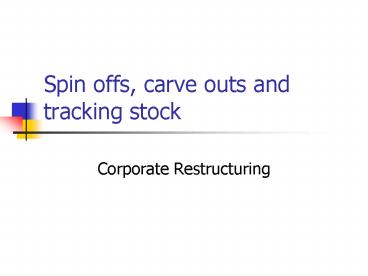Spin offs, carve outs and tracking stock
1 / 19
Title:
Spin offs, carve outs and tracking stock
Description:
Stock market ... Get the stock market to understand business ... Like a carve out, payoff on target stock is a function of the performance of the ... – PowerPoint PPT presentation
Number of Views:96
Avg rating:3.0/5.0
Title: Spin offs, carve outs and tracking stock
1
Spin offs, carve outs and tracking stock
- Corporate Restructuring
2
Motivations for transactions
- Market for corporate control
- Asset are more valuable to alternative management
team - Spin off, carve out, tracking stock
- Unlocking hidden value
- Stock market problem or management problem?
- Improving management incentives
- Spin off, carve out, tracking stock
- Agency costs
- Spin off, carve out, tracking stock
3
Spin offs
- Typically parent corporation distributes on pro
rata basis, all the shares it owns in subsidiary
to its own shareholders. - No cash generally changes hands
- Non taxable event
- as long as it jumps through substantial hoops
4
Spin offs
Company A without Subsidiary B
Company before spin off
Subsidiary B
Shareholders
Shareholders own shares of combined company. Own
the equity in subsidiary implicitly.
5
Spin offs (2)
Company A after spinoff
Company after spin off
New company B
Shareholders receive Shares of company B
Shareholders
Old shareholders still own shares of company A,
which now only represent ownership of A without B.
6
Spin offs in 1990s
- 1991-mid 1996, 100 bn in tax-free spin offs
- Probably another 100 bn since
- Huge ones
- ATT/Lucent Technologies/NCR (97)
- GM/EDS
- Most much smaller
- Internet subsidiaries of bricks and mortar
parents
7
Some recent spin offs
- Pepsi/Tricon
- Pepsi originally wanted to establish a captive
channel for fountain beverage business, but found
they needed to alleviate competitive barriers to
expanding that business (many more restaurant
chains) - Whitman Corporation/Hussman/Midas
- Conglomerate discount, conflicts among management
of divisions - No synergies between bottlers/heavy industry/auto
service - RJR/Nabisco Holdings
- Tobacco litigation, discounting food company
- Carl Icahn, Bennet Lebow
8
Equity carve outs
- Also called partial IPO
- Parent company sells a percentage of the equity
of a subsidiary to the public stock market - Receives cash for the percentage sold
- Can sell any percentage, often just less than
20, just less than 50, are chosen.
9
Equity carve out (partial IPO)
Company before carve out
Company A without subsidieary B
Subsidiary B
Stock market
Shareholders
Shareholders implicitly own 100 of equity of
subsidiary B through their Company A shares.
10
Equity carve out (partial IPO)
Company after carve out
Company A without subsidieary B
Portion of Sub B equity Not sold
X of sub B equity sold To market for cash In IPO
X of Company B shares
Shareholders
Stock market
Shareholders now own 100 of Company A (without
B) And (1-X) of Company B implicitly Through
their company A shares
11
Carve outs
- Why sell a partial stake?
- Pure play
- Get the stock market to understand business
- Once unit is revalued, the parent will be
revalued as well (still owns the rest) - Setting up a sale later
12
Other motives for carve outs
- Divisional managers incentives
- Kraft/Phillip Morris
- Thermo Electron
- Sell hot properties
- Gold subs in mid 80s
- Japanese subs in late 80s
- Internet subs in 97-99
- Why not sell all of it?
13
Targeted stock
- Special class of common stock designed to provide
equity return linked to operating performance of
a distinct business unit (targeted business) - Splits companys operations into two (or more)
publicly traded equity claims, but allows
businesses to remain as wholly owned segments of
parent organization.
14
Target stock vs. spin off
- Spin off creates equity of subsidiary, but
- subsidiary is no longer owned by, or controlled
by the management of parent company - new spun off stock has no equity claim on the
assets or cash flows of the old parent company
15
Target stock vs. carve out
- Like a carve out, payoff on target stock is a
function of the performance of the target
business - Like a carve out, parent company mgmt usually
maintains control over business, but control is
100 w/ target stock - Unlike carve out, the target shares are not
subsidiary shares
16
Target stock is not stock of the targeted business
- Target stock is stock of the consolidated
company, not the targeted business (sub) - Does not represent legal ownership interest in
the assets of the sub - Receives dividend rights against computed
earnings of sub - Voting rights (in decisions of corp) float as
function of market value of the equity of sub
17
Distribution of target shares
- Pro rata stock dividend paid to existing holders
- Sell target shares to new public investors, with
remainder held by parent - proceeds retained by sub
- proceeds allocated elsewhere in company
- Shares issued in acquisition of target company
18
(No Transcript)
19
(No Transcript)





























![Top 5 Tennis Strings for Spin 2021 [Reviewed] PowerPoint PPT Presentation](https://s3.amazonaws.com/images.powershow.com/9683536.th0.jpg?_=202111150212)

